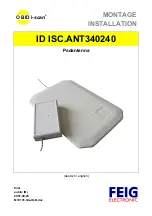
Page
20
of
26
5.4. Kinematic Survey for Rover Stations
In a kinematic, stop and go survey, the stationary receiver (Base station) is set up at a known
point such as a survey monument, or an unknown point. The receiver continually tracks
satellites and logs raw data into its memory. The Rover receiver is set up at an unknown point
and collects data in static mode for 2 to 10 minutes. When finished, assign the Rover to
kinematic status, and move to the next survey point. At this point, and each subsequent point,
the receiver is changed to static mode to collect data. So, while moving, the Rover is in
kinematic mode, and while collecting data, the Rover is in static mode.
•
Set up the Rover at an unknown point and press the Power button.
•
Allow the Rover to collect static data for two to ten minutes. The REC LED will be yellow.
•
Check the SAT light for satellites tracked.
•
When finished, press the Record (FN) button for less than 1 second to assign the Rover
to kinematic.
•
Move the Rover to the next location (survey point) and press the Record (FN) button for
less than a second to collect the data in static mode for two to ten minutes.
•
Repeat the two previous steps until all points have been surveyed. The occupation time
for the points depends on the same factors as for the static survey method.
When finished, press the Record (FN) button for one to five seconds to stop logging data. Turn
off the Rover if needed. This method of GNSS survey allows the operator to reduce the point
occupation time, thus permitting field crews to survey many more points compared to the other
methods available.
5.5. RTK
With RTK surveying, as with kinematic surveying described above, one receiver serves as the
reference station and conducts observations with its antenna affixed to a stationary tripod or
some other device. The other receiver functions as a rover and conducts observations (using an
antenna) affixed to a mobile pole and moved to observation points.
Unlike post-processed kinematic surveys, RTK surveys utilize a communications link between
the Base and Rover. Using a radio modem link, the Base receiver transmits its measurement
and location data to the Rover receiver. The Rover, based on the transmitted data and its own
observation data, immediately conducts a baseline analysis and outputs the results.
Usually, the receiver will start to output the coordinates of the antenna’s phase center along with
the solution type within 10–30 seconds. However, UHF radios and GSM phones may take as
long as 60 seconds to synchronize. The geodetic coordinates displayed on the Location tab are
always computed in WGS84 and have four solution types.
•
Standalone – where the receiver computes 3D coordinates in autonomous mode without
using differential corrections.
•
Code differential – where the Rover receiver computes the current relative coordinate in
differential mode using only pseudo ranges.
•
RTK float – where the Rover receiver computes the current relative coordinates in
differential mode using both pseudo ranges and phases; however, with a float solution,
the phase ambiguity is not a fixed integer number, and the “float” estimate is used
instead.







































